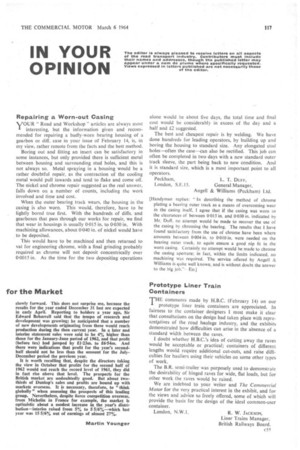IN YOUR OPINION
Page 119

If you've noticed an error in this article please click here to report it so we can fix it.
Repairing a Worn-out Casing VOUR "Road and Workshop" articles are always most I interesting, but the information given and recommended for repairing a badly-worn bearing housing of a gearbox or diff, case in your issue of February 14, is, in my view, rather remote from the facts and the best method.
Boring out and fitting an insert can be satisfactory in some instances, but only provided there is sufficient metal between housing and surrounding stud holes, and this is not always so. Metal spraying in a housing would be a rather doubtful repair, as the contraction of the cooling metal would pull inwards and tend to flake and come off. The nickel and chrome repair suggested as the real answer, falls down on a number of counts, including the work involved and time and cost.
When the outer bearing track wears, the housing in the casing is also worn. This would, therefore, have to be lightly bored true first. With the hundreds of diffs. and gearboxes that pass through our works for repair, we find that wear in housings is usually 0-015 in. to 0-030 in. With machining allowances, about 0-040 in. of nickel would have to be deposited.
This would have to be machined and then returned to vat for engineering chrome, with a final grinding probably required as chrome will not deposit concentrically over 0-0015 in. As the time for the two depositing operations alone would be about five days, the total time and final cost would be considerably in excess of the day and a half and £2 suggested.
The best and cheapest repair is by welding. We have done hundreds for leading operators, by building up and boring the housing to standard size. Any elongated stud holes—often the case—can also be rectified. This job can often be completed in two days with a new standard outer track sleeve, the part being back to new condition. And it is standard size, which is a most important point to all operators.
Peckham, London, S.E.15. L. T. DUFF, General Manager, Angell & Williams (Peckham) Ltd.
[Handyman replies: " In describing the method of chrome plating a bearing outer track as a means of overcoming wear in the casing itself, I agree that if the casing was worn to the clearances of between 0.015 in and 0.030 in. indicated by Mr. Duff, no attempt would be made to recover the use of the casing by chroming the bearing. The results that I have found satisfactory from the use of chrome have been where amounts between 0-004 in. to 0-010 in. were needed on the bearing outer track, to again ensure a goad nip tit in the worn casing. Certainly no attempt -would be made to chrome the casing aperture; in fact, within the limits indicated, no machining was required. The service offered by Angell & Williams is quite well known, and is without doubt the answer to the big job."-ED.]
Prototype Liner Train Containers
THE, comments made by H.B.C. (February 14) on our I prototype liner train containers are appreciated, In fairness to the container designers I must make it clear that consultations on the design had taken place with represenkatives of the road haulage industry, and the exhibits demonstrated how difficulties can arise in the absence of a standard width between the raves, I doubt whether H.B.C.'s idea of cutting away the raves would be acceptable or practical; containers of different lengths would require additional cut-outs, and raise difficulties for hauliers using their vehicles on some other types of work.
The B.R. semi-trailer was purposely used to demonstrate the desirability of hinged raves for wide, flat loads, but for other work the raves would be raised.
We are indebted to your writer and The Commercial Motor for the very practical interest in the exhibit, and for the views and advice so freely offered, some of which will provide the basis for the design of the ideal common-user container.
London, N.W.1. R. W. JACKSON, Liner Trains Manager, British Railways Board.




































































































































































